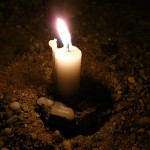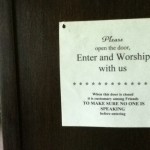Part I: A Very Differen Book From Genesis
Part II: God Becoming God
Part III: Thou Shalt Not Suffer A Witch To Live
Part IV: A Graven Image Is Worth A Thousand Words
A Graven Image Is Worth A Thousand Words
What it says is:
You shall not make for yourself a sculptured image, or any likeness of what is in the heavens above, or on the earth below, or in the waters under the earth. You shall not bow down to them or serve them. For I the LORD your God am an impassioned God, visiting the guilt of the parents upon the children, upon the third and upon the fourth generations of those who reject Me, but showing kindness to the thousandth generation of those who love Me and keep My commandments. (JPS, Exodus 20:4-6)
Murder, adultery, and stealing He let go with a simple statement. For graven images, He goes out of His way to promise punishment down to the great-grandchildren. And it’s not just idols, not just images of God(s), it’s images of anything. What’s up with that? And, given its prominence in the Law, what’s up with all those crucifixes in churches?
Marshall Massey, in a comment on an earlier post, says:
Well, if you know your religious history, you know that there have always been some Christians who understood this as being more and deeper than a “tribal taboo”, and honored it accordingly. Thus the first generations of Christians made no images, which is why we don’t know what Christ looked like. In Byzantium, a few centuries later, there were pitched battles between the iconoclasts, who wanted to destroy all graven images of holy things, and the iconodules, who liked having them as objects of veneration. The iconodules won, but it was a near thing.
In Puritan England, at the time that the Quaker movement was beginning, there was a widespread feeling that the victory of the iconodules had been just one more instance of the general apostasy of the church; a new wave of iconoclasts arose and invaded the churches and cathedrals of England and Scotland and destroyed countless works of art, some of them great. Early Friends joined with the Puritans in rejecting crucifixes and stained glass portraits, not just on the grounds that these were forbidden in the Bible, but because their own hearts affirmed that an image is a vanity, i.e. something empty, and as such a distraction from the true God.
Even today, many Protestants uphold the ban on images; I’ve heard of one Scottish preacher, invited to preach in a church of a different denomination at Christmastide, who began his appearance by taking off his frock and throwing it over the crèche on the stage, so as to cover the blasphemy of that image, and its power to distract from the true God, for at least as long as he was there.
The Jewish temple was of course devoid of graven images; the Holy of Holies had no image in it. Islam makes no graven images, because it recognizes the truth of that commandment; all its art is abstract.
And the thought is hardly restricted to the so-called Abrahamic religions. The Taoists make no images of God, you know; they see God as beyond all such. The early Buddhists made no images either; all the images you’ve seen of the Buddha date from after the incursion of Alexander the Great. Some of the greatest Zen teachers were notoriously scornful of images, one of them even to the point of burning one.
Tribal taboo, then? Or separate discoveries of the same truth, which is that the Infinite and Uncreate cannot be contained in a form?
As always, Marshall is very thought provoking and has a depth of historical and scriptural knowledge that makes him impossible to simply dismiss. But, as is often the case too, Marshall’s comment leaves me feeling that there is something wrong in what he said that I just haven’t been able to put my finger on yet.
Yes, there have been iconoclastic sects within Christianity, including the forebears and early roots of our own Quaker tradition. And I’ll take Marshall’s word for it that the early Christians made no images. But even at their most extreme. Christian iconoclasts have only objected to religious iconography. Islam is the only Abrahamic religion I know of that avoids all representational art of any kind. I don’t draw any great conclusions from this. It just puzzles me. This one has always puzzled me, ever since I was a child turning the pages of the big black King James we had from the Reader’s Digest Press.
For that matter, what about the golden cherubim that ornament the Ark of the Covenant? *shrug*
Where I sharply disagree with Marshall’s comment is when he compares the Hebrew injunction against images to the attitudes of the Taoists and Buddhists. He’s very right in describing the Taoist conception of “God as beyond all such.” But that’s not what the Hebrews were saying.
Even the finest teaching is not the Tao itself.
Even the finest name is insufficient to define it.
Without words, the Tao can be experienced,
and without a name, it can be known.(Tao Te Ching, chapter 1, Stan Rosenthal trans.)
This stands in direct opposition to:
In the beginning was the Word,
and the Word was with God,
and the Word was God.(RSV, Gospel of John 1:1)
The Hebrews forbade sculpted images, and Hebrew culture never did much with the visual arts generally, but with their words they painted pictures that could make your hair stand on end or your spirit soar.
I looked, and lo, a stormy wind came sweeping out of the north—a huge cloud and flashing fire, surrounded by a radiance; and in the center of it, in the center of the fire, a gleam of amber. In the center of it were also the figures of four creatures. And this was their appearance:
They had the figures of human beings. However, each had four faces, and each of them had four wings; the legs of each were [fused into] a single rigid leg, and the feet of each were like a single calf’s hoof; and their sparkle was like the luster of burnished bronze. They had human hands below their wings. The four of them had their faces and their wings on their four sides. Each one’s wings touched those of the other. Their did not turn when they moved; each could move in the direction of any of its faces; they went wherever the spirit impelled them to go, without turning when they moved.
(JPS, Ezekiel 1:4-12)
The description goes on for another two pages, and it is some of the most visually intense writing I’ve ever read. They did make pictures of their God. It’s not sculpted, but there’s no way you’re going to tell me those words don’t make an image.
So I’m still just really puzzled by what the second commandment means. To us. To them. To anybody.
















